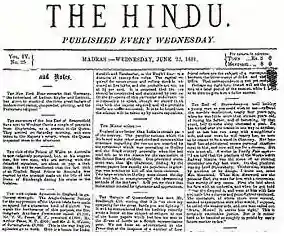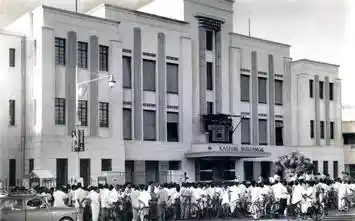A Printed Revolution
It's not just a piece of paper, but a journey- a mashal ignited by the Triplicane Six, and the Kasturi family never let the fire blow off. From the past to the present, it has managed to grasp the crown of retaining the highest of viewers, nationally and internationally, a journey of one powerful media-journalism.

The legendary journey of 140 years. Image Source: Quora/Public Domain
The annual session of the Indian National Congress, which was held in Madras, the paper’s coverage of national news boosted specifically, leading The Hindu to start as an evening daily from April 01, 1889. Unfortunately, as we know, no happiness is long lasting and so, the initial success brought in a bad news in 1898. The powerful duo, Subramania Iyer and Veera Raghavacharya, was shattered as Subramania chose to quit. Veera Raghavacharya as the sole owner took in C. Karunakara Menon as the editor. But the Titanic had already hit the iceberg. The vogue and circulation of the copies were reduced to 800 by the 1900s, bringing Raghavacharya to the decision of selling it.
It was purchased by the legal advisor of The Hindu, S. Kasturi Ranga Iyenger, an ambitious lawyer who had migrated from a village to Coimbatore and the Madras, for practising. His great interest in journalism pushed him to pursue this big buy.
The Hindu is an English newspaper founded as a weekly in 1878 and as a daily in1889, in India. It was established in Madras on 20th September, 1878. It is the country’s second, in the section of most circulated English newspapers, after The Times of India. (P.S. : I am sorry The Telegraph! I know it must feel bad)
It was founded by a group of six people: four law students- T. T. Rangacharya, P.V. Rangacharya, D. Kesava Rao Pantulu, N. Subba Rao Pantulu, and two teachers- G. Subramania Iyer and M. Veera Raghavacharya. Together, they were known as the Triplicane Six, a very unusual college hangout team. The Hindu was created with the aim of Sir T. Muthuswamy Iyer’s campaign at the Madras High Court for the mediator-ship and to tackle the campaign the British carried against him, through their own biased Press. The Hindu worked on challenging such Anglo-Indian Press and voices their objections against the prejudiced British policies.
Subramania Iyer was declared the first editor and Veera Raghavacharya, the first managing director of the newspaper.
After his death, his son, Kasturi Srinivasan, became the managing director in 1923 and 1934, the Chief Editor. Thereafter, the descendants of Kasturi Ranga Iyenger, have looked after The Hindu and took the responsibility of its prestige to be at the top, as an heirloom. The readers’ complaints about The Hindu losing its virtue due to visible political inclinations were also removed and assured by the young descendants.
With India winning its independence, The Hindu was escalated to foreign bureaus in Dhaka, Islamabad, Colombo, Washington D.C., London, Dubai, etc.
The newspaper is an achiever as the first to introduce colour print in 1940. The path breaking pioneering was seen when it started publishing online in 1995 as the first of its kind. In 1963, airplanes were owned to distribute the copies on a larger scale.
In this 21st Century, the daily circulation of The Hindu exceeded 9lakhs. The Hindu Group Publications now also publishes a daily business newspaper, The Hindu Business Line, and magazines like Frontline and Sportstar. It also comprises of various signified columns of Reviews, Classified, Habitat, Science, Engineering, Technology and Agriculture, Young World, and, Nxg.
The Hindu is considered as our country's heritage and the safe hands of the Kasturi Family have not only preserved its integrity, also perpetually modified it with time and generations.
At Srinidhi Press, about 100 inaugural copies of The Hindu were printed, but later it was moved to Scottish Press, then to Hindu Press, Mylapore. Its success made it a tri-weekly in 1883 and evening daily in 1889. The inaugural copies were made rental at the price of one rupee and twelve annas, whereas now, the issues were selling at four annas per copy.
The office was moved to a premise which was rented at 100 Mount Road, in 1883. With the Maharaja of Vizianagaram’s very generous loan offered to the Hindu, the entire building was bought by The Hindu. The loan offered the expense to carry out other charges as well. The newspaper started printing on its new found self claimed press, The National Press, which successfully caught Maharaja’s sight. Its editorial stance brought The Hindu, with respect, to be called, The Maha Vishnu of the Mount Road, where its the then office was.

The lawyer who gave it all to his fondness towards journalism. Image Source: epichindi

The divine building at Mount Road. Image Source: Business Line

Subramania Iyer, the heart of The Hindu. Image Source: Twitter/Public Domain


